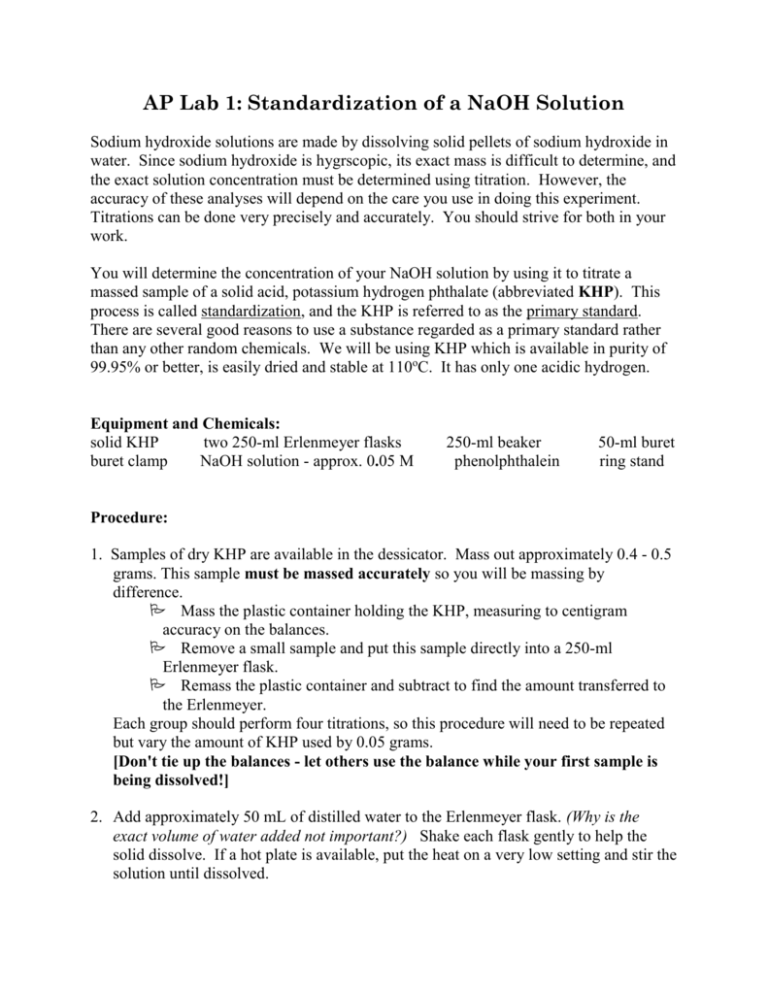AP Lab 1: Standardization of a NaOH Solution
advertisement

AP Lab 1: Standardization of a NaOH Solution Sodium hydroxide solutions are made by dissolving solid pellets of sodium hydroxide in water. Since sodium hydroxide is hygrscopic, its exact mass is difficult to determine, and the exact solution concentration must be determined using titration. However, the accuracy of these analyses will depend on the care you use in doing this experiment. Titrations can be done very precisely and accurately. You should strive for both in your work. You will determine the concentration of your NaOH solution by using it to titrate a massed sample of a solid acid, potassium hydrogen phthalate (abbreviated KHP). This process is called standardization, and the KHP is referred to as the primary standard. There are several good reasons to use a substance regarded as a primary standard rather than any other random chemicals. We will be using KHP which is available in purity of 99.95% or better, is easily dried and stable at 110oC. It has only one acidic hydrogen. Equipment and Chemicals: solid KHP two 250-ml Erlenmeyer flasks buret clamp NaOH solution - approx. 0.05 M 250-ml beaker phenolphthalein 50-ml buret ring stand Procedure: 1. Samples of dry KHP are available in the dessicator. Mass out approximately 0.4 - 0.5 grams. This sample must be massed accurately so you will be massing by difference. Mass the plastic container holding the KHP, measuring to centigram accuracy on the balances. Remove a small sample and put this sample directly into a 250-ml Erlenmeyer flask. Remass the plastic container and subtract to find the amount transferred to the Erlenmeyer. Each group should perform four titrations, so this procedure will need to be repeated but vary the amount of KHP used by 0.05 grams. [Don't tie up the balances - let others use the balance while your first sample is being dissolved!] 2. Add approximately 50 mL of distilled water to the Erlenmeyer flask. (Why is the exact volume of water added not important?) Shake each flask gently to help the solid dissolve. If a hot plate is available, put the heat on a very low setting and stir the solution until dissolved. 3. While you are waiting for the KHP to dissolve, go ahead and prepare your buret. Fill a 250-ml beaker with tap water and rinse your buret at least three times. Check to see if any water droplets adhere to the inside of the buret. If beading occurs, your buret needs to be cleaned with a soap solution. If you must wash your buret with a soap solution, be sure to thoroughly rinse all soap residue from the burets - including a distilled water rinse. 4. Rinse the buret with about 5-10 ml of the NaOH solution. This wash serves to remove any water from the buret. 5. Fill the buret. Allow a small amount of the base solution to drain, filling the tip. Check to make sure that the bottom of the meniscus sits on the 0.00-mL line for your first titration. 6. When the KHP has completely dissolved add 3 - 5 drops of the phenolphthalein indicator to the acid solution. 7. Titrate the solution in the Erlenmeyer flask with the NaOH solution to the first, faintest, permanent pink color, being sure to stir constantly. (A permanent color means one that lasts at least 30 seconds. CO2 from the air will lower the pH of the solution slightly, so the pink color may fade after about one minute.) Do not overshoot the equivalence point! A dark magenta color means you have gone too far and will have to start over. Some tips on how to avoid overshooting the equivalence point: a. Constant stirring will help the solutions mix better, and will allow the base to react with the acid quicker. b. You can tell when you are approaching the equivalence point because where the drops of base enter the solution, there will be a pink area. This area will enlarge and become more persistent as you get closer to the equivalence point. c. The stopcocks are designed to be turned in either direction. Positioning the stopcock perpendicular to the barrel completely stops the flow. If you will practice quickly turning the stopcock 180o, you can actually master the skill of adding 1/2 drops. One drop is only 0.05 ml, so you can theoretically increase the volume by only 0.025 ml! 8. Record the total volume of NaOH solution used. Record the initial buret volume reading as well as the final buret volume reading. Remember that the scale is inverted - as the volume goes down, the marking increase. If you started at the 0.00-ml mark and the final volume reading has the meniscus sitting on the 24.50-ml mark, you have used 24.50 ml of NaOH solution. All buret readings should be read to the nearest 0.00-ml mark. The hundredth reading is the approximation - estimate it as either .00ml or .05-ml. 9. Repeat the titration with your other three samples. 10. The reason for the four trials is for accuracy as well as precision. You need at least three trials that agree to within 4 %. If only one trial deviates from the average molarity by more than 4%, it may be discarded. If more than one trial shows too much deviation, though, you will need to perform an additional titration. Calculations Moles of KHP massed in each trial Moles of NaOH used to neutralize the KHP in each trial Volume of NaOH used to reach the equivalence point (in liters) in each trial Molarity of NaOH solution for each trial Average molarity of NaOH solution Deviation from class average ….And, you’re done! But now what should you do? A Formal Lab Write Up! Follow the guidelines set forth in the AP Lab Manual. (You know, the one you read on the first day of school...you did read it, didn’t you?)











